Management Accounting Analysis for Playdough Company Report
VerifiedAdded on 2019/11/25
|9
|1533
|163
Report
AI Summary
This report provides a detailed analysis of management accounting principles applied to the Playdough Company. It begins by calculating the cost per unit of producing canisters using the traditional costing method, establishing a baseline for financial analysis. The report then explores the make-or-buy decision, comparing the profitability of manufacturing canisters versus purchasing them from an external supplier, and determines that manufacturing is the more profitable option. A crucial part of the analysis evaluates a special order of 20,000 canisters, concluding that accepting this order would result in a loss. The report outlines the factors the firm should consider before accepting the special order, emphasizing financial capability, profitability, and cost. Furthermore, the report assesses the strategic implications of purchasing canisters while manufacturing coffee cups, concluding that this combination yields a higher overall profit. Finally, it discusses the key factors, including profitability, resource availability, and product quality, that the company must consider when deciding between manufacturing and purchasing canisters. The report uses financial data and calculations to support its conclusions, offering valuable insights into the financial management of the Playdough Company.
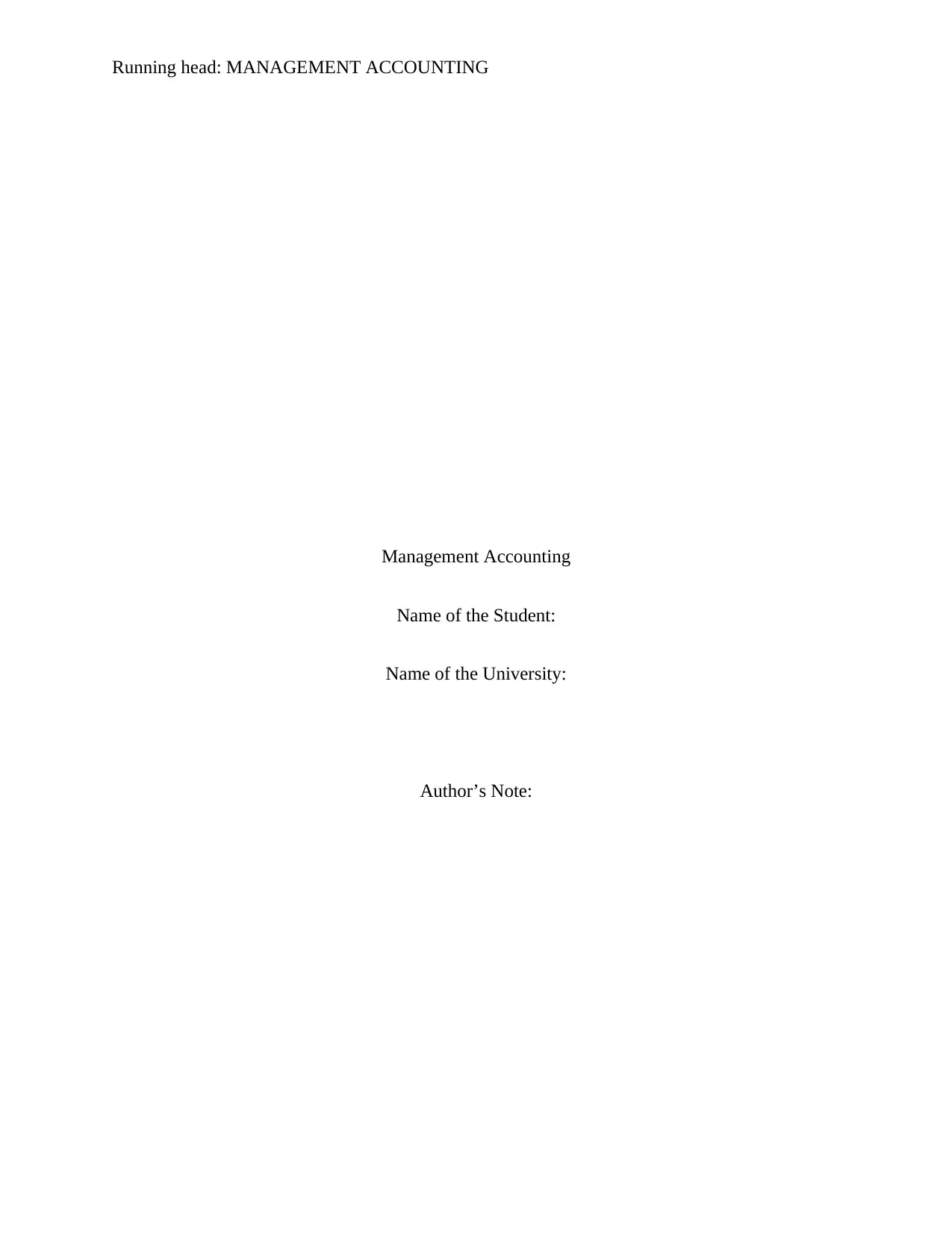
Running head: MANAGEMENT ACCOUNTING
Management Accounting
Name of the Student:
Name of the University:
Author’s Note:
Management Accounting
Name of the Student:
Name of the University:
Author’s Note:
Paraphrase This Document
Need a fresh take? Get an instant paraphrase of this document with our AI Paraphraser
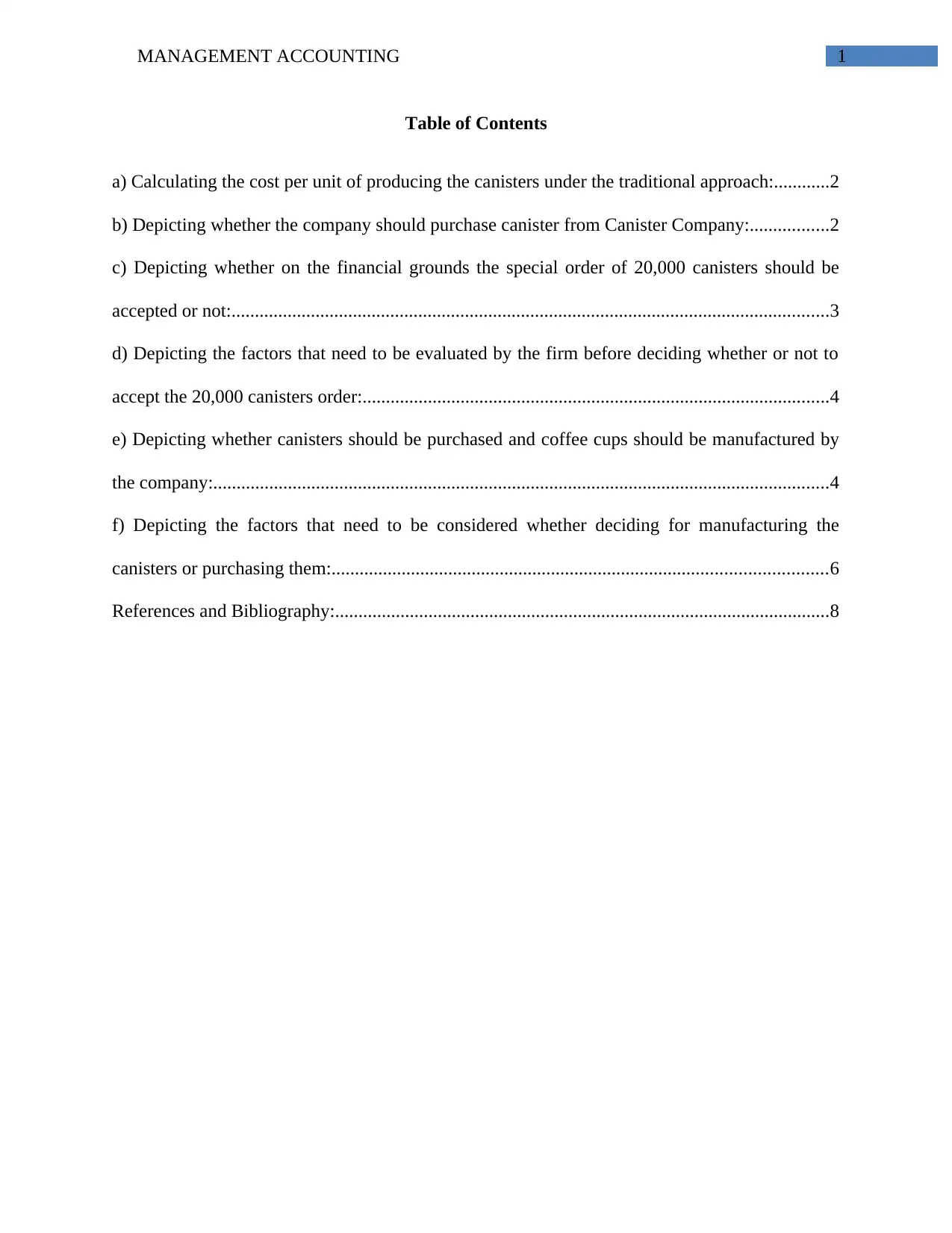
MANAGEMENT ACCOUNTING 1
Table of Contents
a) Calculating the cost per unit of producing the canisters under the traditional approach:............2
b) Depicting whether the company should purchase canister from Canister Company:.................2
c) Depicting whether on the financial grounds the special order of 20,000 canisters should be
accepted or not:................................................................................................................................3
d) Depicting the factors that need to be evaluated by the firm before deciding whether or not to
accept the 20,000 canisters order:....................................................................................................4
e) Depicting whether canisters should be purchased and coffee cups should be manufactured by
the company:....................................................................................................................................4
f) Depicting the factors that need to be considered whether deciding for manufacturing the
canisters or purchasing them:..........................................................................................................6
References and Bibliography:..........................................................................................................8
Table of Contents
a) Calculating the cost per unit of producing the canisters under the traditional approach:............2
b) Depicting whether the company should purchase canister from Canister Company:.................2
c) Depicting whether on the financial grounds the special order of 20,000 canisters should be
accepted or not:................................................................................................................................3
d) Depicting the factors that need to be evaluated by the firm before deciding whether or not to
accept the 20,000 canisters order:....................................................................................................4
e) Depicting whether canisters should be purchased and coffee cups should be manufactured by
the company:....................................................................................................................................4
f) Depicting the factors that need to be considered whether deciding for manufacturing the
canisters or purchasing them:..........................................................................................................6
References and Bibliography:..........................................................................................................8
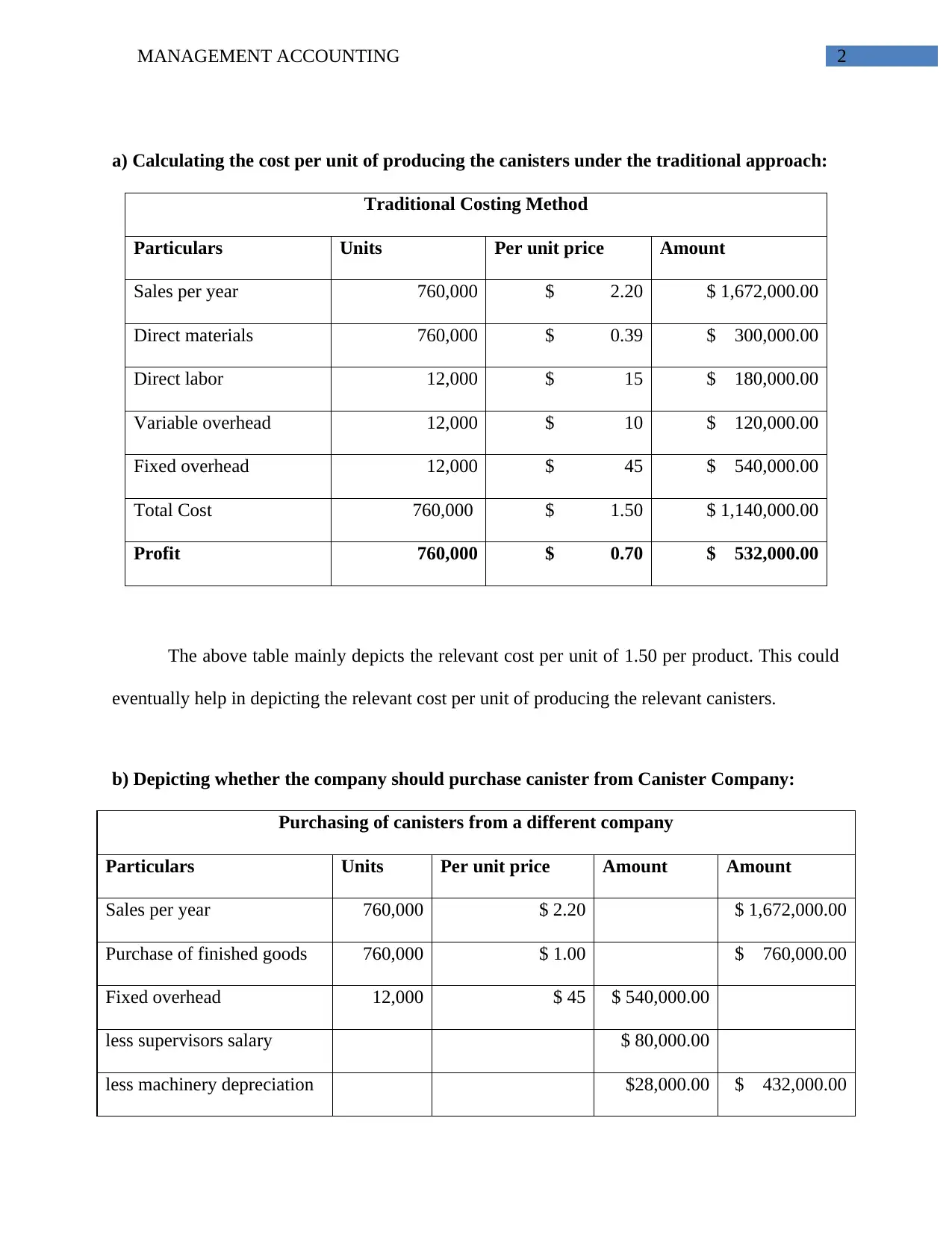
MANAGEMENT ACCOUNTING 2
a) Calculating the cost per unit of producing the canisters under the traditional approach:
Traditional Costing Method
Particulars Units Per unit price Amount
Sales per year 760,000 $ 2.20 $ 1,672,000.00
Direct materials 760,000 $ 0.39 $ 300,000.00
Direct labor 12,000 $ 15 $ 180,000.00
Variable overhead 12,000 $ 10 $ 120,000.00
Fixed overhead 12,000 $ 45 $ 540,000.00
Total Cost 760,000 $ 1.50 $ 1,140,000.00
Profit 760,000 $ 0.70 $ 532,000.00
The above table mainly depicts the relevant cost per unit of 1.50 per product. This could
eventually help in depicting the relevant cost per unit of producing the relevant canisters.
b) Depicting whether the company should purchase canister from Canister Company:
Purchasing of canisters from a different company
Particulars Units Per unit price Amount Amount
Sales per year 760,000 $ 2.20 $ 1,672,000.00
Purchase of finished goods 760,000 $ 1.00 $ 760,000.00
Fixed overhead 12,000 $ 45 $ 540,000.00
less supervisors salary $ 80,000.00
less machinery depreciation $28,000.00 $ 432,000.00
a) Calculating the cost per unit of producing the canisters under the traditional approach:
Traditional Costing Method
Particulars Units Per unit price Amount
Sales per year 760,000 $ 2.20 $ 1,672,000.00
Direct materials 760,000 $ 0.39 $ 300,000.00
Direct labor 12,000 $ 15 $ 180,000.00
Variable overhead 12,000 $ 10 $ 120,000.00
Fixed overhead 12,000 $ 45 $ 540,000.00
Total Cost 760,000 $ 1.50 $ 1,140,000.00
Profit 760,000 $ 0.70 $ 532,000.00
The above table mainly depicts the relevant cost per unit of 1.50 per product. This could
eventually help in depicting the relevant cost per unit of producing the relevant canisters.
b) Depicting whether the company should purchase canister from Canister Company:
Purchasing of canisters from a different company
Particulars Units Per unit price Amount Amount
Sales per year 760,000 $ 2.20 $ 1,672,000.00
Purchase of finished goods 760,000 $ 1.00 $ 760,000.00
Fixed overhead 12,000 $ 45 $ 540,000.00
less supervisors salary $ 80,000.00
less machinery depreciation $28,000.00 $ 432,000.00
⊘ This is a preview!⊘
Do you want full access?
Subscribe today to unlock all pages.

Trusted by 1+ million students worldwide
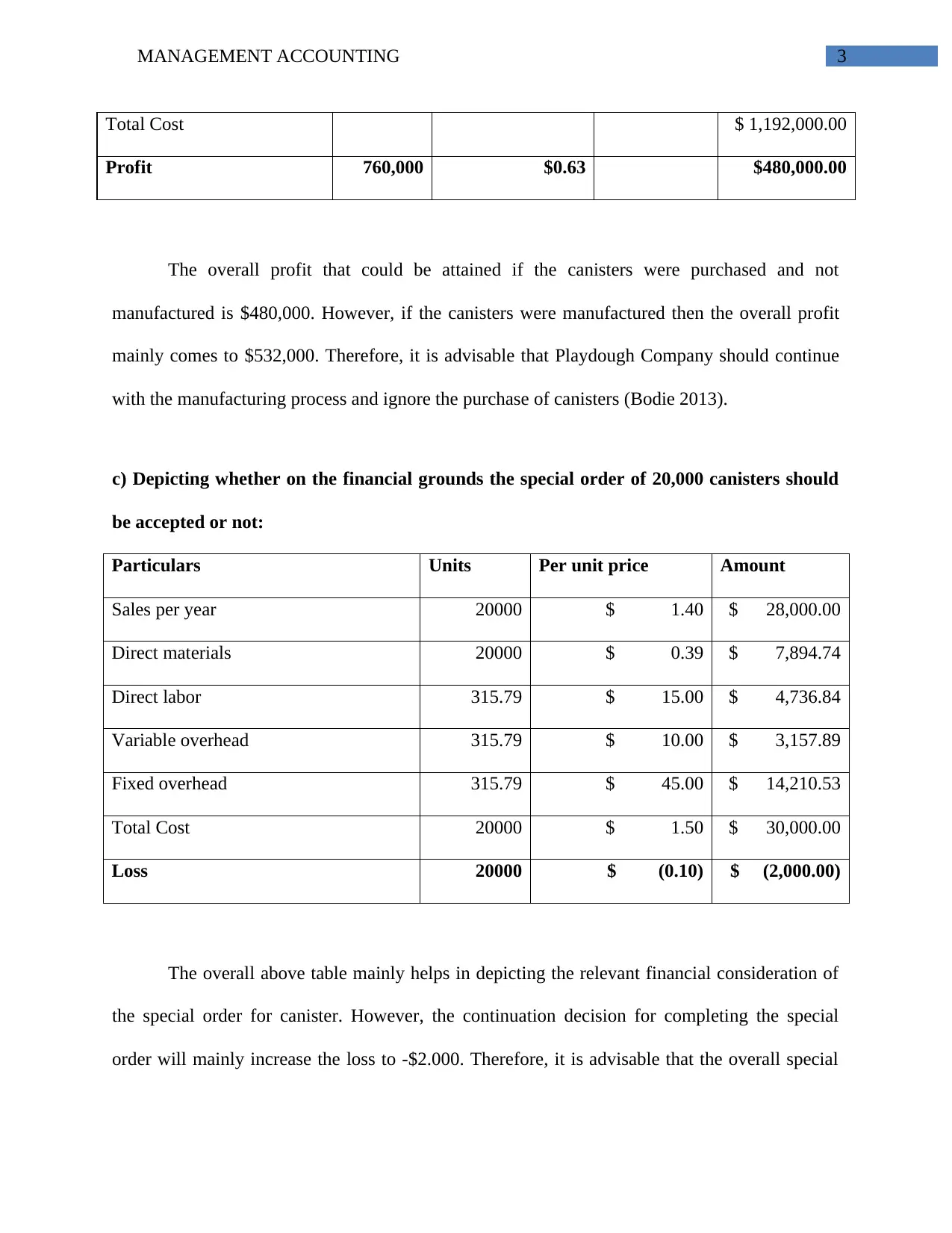
MANAGEMENT ACCOUNTING 3
Total Cost $ 1,192,000.00
Profit 760,000 $0.63 $480,000.00
The overall profit that could be attained if the canisters were purchased and not
manufactured is $480,000. However, if the canisters were manufactured then the overall profit
mainly comes to $532,000. Therefore, it is advisable that Playdough Company should continue
with the manufacturing process and ignore the purchase of canisters (Bodie 2013).
c) Depicting whether on the financial grounds the special order of 20,000 canisters should
be accepted or not:
Particulars Units Per unit price Amount
Sales per year 20000 $ 1.40 $ 28,000.00
Direct materials 20000 $ 0.39 $ 7,894.74
Direct labor 315.79 $ 15.00 $ 4,736.84
Variable overhead 315.79 $ 10.00 $ 3,157.89
Fixed overhead 315.79 $ 45.00 $ 14,210.53
Total Cost 20000 $ 1.50 $ 30,000.00
Loss 20000 $ (0.10) $ (2,000.00)
The overall above table mainly helps in depicting the relevant financial consideration of
the special order for canister. However, the continuation decision for completing the special
order will mainly increase the loss to -$2.000. Therefore, it is advisable that the overall special
Total Cost $ 1,192,000.00
Profit 760,000 $0.63 $480,000.00
The overall profit that could be attained if the canisters were purchased and not
manufactured is $480,000. However, if the canisters were manufactured then the overall profit
mainly comes to $532,000. Therefore, it is advisable that Playdough Company should continue
with the manufacturing process and ignore the purchase of canisters (Bodie 2013).
c) Depicting whether on the financial grounds the special order of 20,000 canisters should
be accepted or not:
Particulars Units Per unit price Amount
Sales per year 20000 $ 1.40 $ 28,000.00
Direct materials 20000 $ 0.39 $ 7,894.74
Direct labor 315.79 $ 15.00 $ 4,736.84
Variable overhead 315.79 $ 10.00 $ 3,157.89
Fixed overhead 315.79 $ 45.00 $ 14,210.53
Total Cost 20000 $ 1.50 $ 30,000.00
Loss 20000 $ (0.10) $ (2,000.00)
The overall above table mainly helps in depicting the relevant financial consideration of
the special order for canister. However, the continuation decision for completing the special
order will mainly increase the loss to -$2.000. Therefore, it is advisable that the overall special
Paraphrase This Document
Need a fresh take? Get an instant paraphrase of this document with our AI Paraphraser
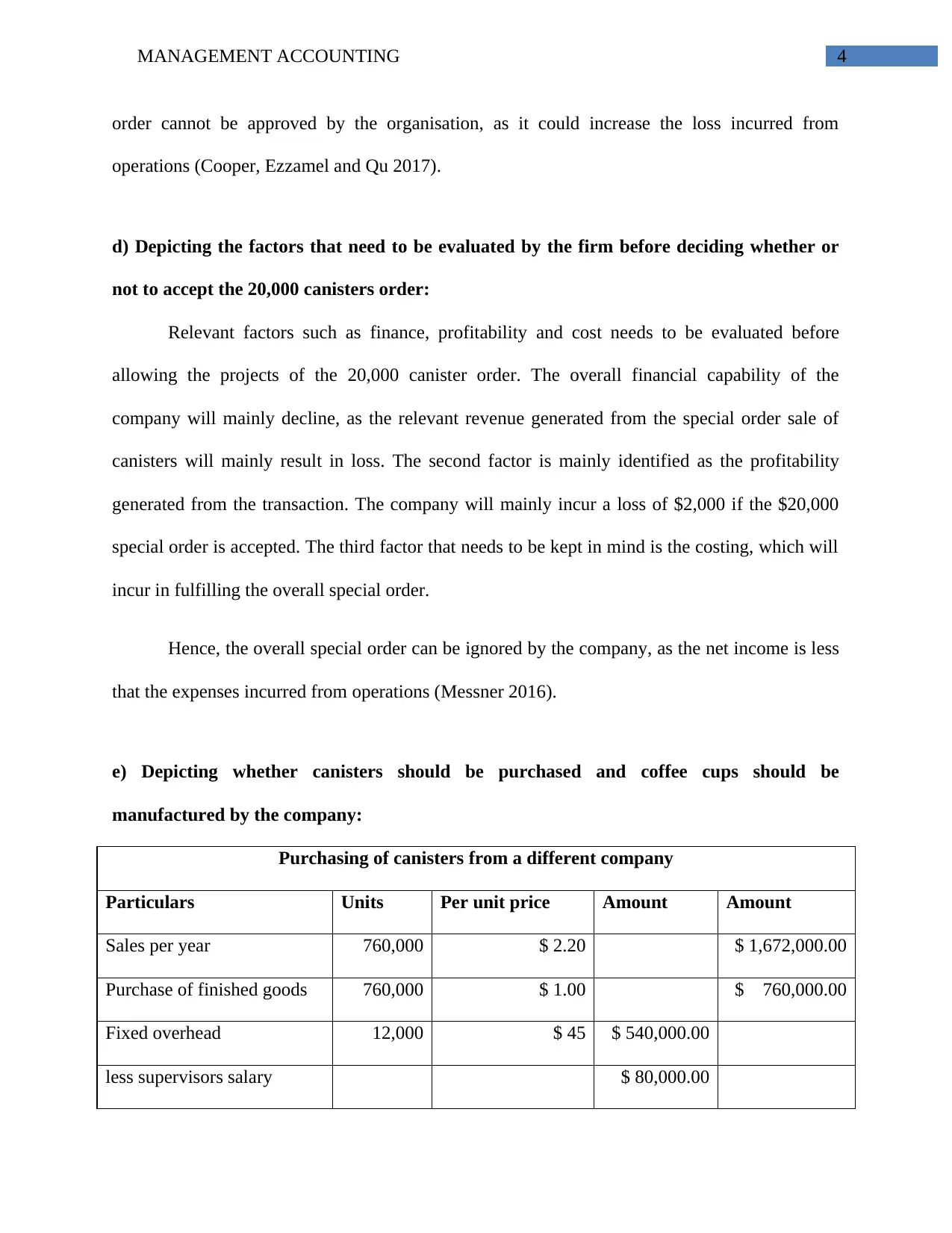
MANAGEMENT ACCOUNTING 4
order cannot be approved by the organisation, as it could increase the loss incurred from
operations (Cooper, Ezzamel and Qu 2017).
d) Depicting the factors that need to be evaluated by the firm before deciding whether or
not to accept the 20,000 canisters order:
Relevant factors such as finance, profitability and cost needs to be evaluated before
allowing the projects of the 20,000 canister order. The overall financial capability of the
company will mainly decline, as the relevant revenue generated from the special order sale of
canisters will mainly result in loss. The second factor is mainly identified as the profitability
generated from the transaction. The company will mainly incur a loss of $2,000 if the $20,000
special order is accepted. The third factor that needs to be kept in mind is the costing, which will
incur in fulfilling the overall special order.
Hence, the overall special order can be ignored by the company, as the net income is less
that the expenses incurred from operations (Messner 2016).
e) Depicting whether canisters should be purchased and coffee cups should be
manufactured by the company:
Purchasing of canisters from a different company
Particulars Units Per unit price Amount Amount
Sales per year 760,000 $ 2.20 $ 1,672,000.00
Purchase of finished goods 760,000 $ 1.00 $ 760,000.00
Fixed overhead 12,000 $ 45 $ 540,000.00
less supervisors salary $ 80,000.00
order cannot be approved by the organisation, as it could increase the loss incurred from
operations (Cooper, Ezzamel and Qu 2017).
d) Depicting the factors that need to be evaluated by the firm before deciding whether or
not to accept the 20,000 canisters order:
Relevant factors such as finance, profitability and cost needs to be evaluated before
allowing the projects of the 20,000 canister order. The overall financial capability of the
company will mainly decline, as the relevant revenue generated from the special order sale of
canisters will mainly result in loss. The second factor is mainly identified as the profitability
generated from the transaction. The company will mainly incur a loss of $2,000 if the $20,000
special order is accepted. The third factor that needs to be kept in mind is the costing, which will
incur in fulfilling the overall special order.
Hence, the overall special order can be ignored by the company, as the net income is less
that the expenses incurred from operations (Messner 2016).
e) Depicting whether canisters should be purchased and coffee cups should be
manufactured by the company:
Purchasing of canisters from a different company
Particulars Units Per unit price Amount Amount
Sales per year 760,000 $ 2.20 $ 1,672,000.00
Purchase of finished goods 760,000 $ 1.00 $ 760,000.00
Fixed overhead 12,000 $ 45 $ 540,000.00
less supervisors salary $ 80,000.00

MANAGEMENT ACCOUNTING 5
less machinery depreciation $28,000.00 $ 432,000.00
Total Cost $ 1,192,000.00
Profit 760,000 $0.63 $480,000.00
Manufacturing of coffee cups
Particulars Units Per unit price Amount Amount
Sales per year 400,000.00 $ 1.20 $ 480,000.00
Direct material 400,000.00 $ 0.60 $ 240,000.00
Direct labour 400,000.00 $ 0.20 $ 80,000.00
Variable overhead 400,000.00 $ 0.10 $ 40,000.00
Fixed overhead 400,000.00 $ 0.15 $ 60,000.00
Total Cost $ 420,000.00
Profit from Coffee cups 400,000.00 $ 0.15 $ 60,000.00
Particulars Amount
Profits from Canister sale $ 480,000.00
Profit from Coffee cups $ 60,000.00
Total Profit from two production $ 540,000.00
Previous profit from single production $ 532,000.00
Net increase in profit if two production is used $ 8,000.00
less machinery depreciation $28,000.00 $ 432,000.00
Total Cost $ 1,192,000.00
Profit 760,000 $0.63 $480,000.00
Manufacturing of coffee cups
Particulars Units Per unit price Amount Amount
Sales per year 400,000.00 $ 1.20 $ 480,000.00
Direct material 400,000.00 $ 0.60 $ 240,000.00
Direct labour 400,000.00 $ 0.20 $ 80,000.00
Variable overhead 400,000.00 $ 0.10 $ 40,000.00
Fixed overhead 400,000.00 $ 0.15 $ 60,000.00
Total Cost $ 420,000.00
Profit from Coffee cups 400,000.00 $ 0.15 $ 60,000.00
Particulars Amount
Profits from Canister sale $ 480,000.00
Profit from Coffee cups $ 60,000.00
Total Profit from two production $ 540,000.00
Previous profit from single production $ 532,000.00
Net increase in profit if two production is used $ 8,000.00
⊘ This is a preview!⊘
Do you want full access?
Subscribe today to unlock all pages.

Trusted by 1+ million students worldwide

MANAGEMENT ACCOUNTING 6
Therefore, the overall evaluation of the situation of purchasing the canisters and
manufacturing the coffee cup could be identified from the above table. Hence, the use of
manufacturing process for Coffee cup and purchase process for canisters could eventually
generate a total revenue of $ 540,000.00. Therefore, the use of both the coffee cup and canister
system could eventually help in generating a more income of $ 8,000. Thus, use of these
measures could eventually help in generating a higher income from investment, if both coffee
cup and canisters are used for the selling process (Otley and Emmanuel 2013).
f) Depicting the factors that need to be considered whether deciding for manufacturing the
canisters or purchasing them:
There are relevant factors that need to be evaluated before taking any kind of decision.
The factors that need to be considered are profitability, availability of resources and quality,
which help in making relevant decision. The first factor is relevantly the profitability factor,
which needs to be evaluated for identifying the over profitability that is generated from the
operations. Currently, it is seen that using manufacturing process of coffee cups and outsourcing
the canisters could help in generating an extra income of $8,000. Moreover, the second factor is
mainly identified, as availability of resources, where the company needs to buy new machines
for the manufacturing of the coffee cup. Hence, it could be assumed that organisation with the
new manufacturing process is by investing newly in the equipments. This overall cost is mainly
ignored in the evaluation, which plays a relevant factor in identifying the actual cost that might
incur from operations (Quinn 2014).
The last factor is mainly identified, as the quality of the product, which needs to be
maintained by the company. If the quality of the product demurs then eventually the demand for
Therefore, the overall evaluation of the situation of purchasing the canisters and
manufacturing the coffee cup could be identified from the above table. Hence, the use of
manufacturing process for Coffee cup and purchase process for canisters could eventually
generate a total revenue of $ 540,000.00. Therefore, the use of both the coffee cup and canister
system could eventually help in generating a more income of $ 8,000. Thus, use of these
measures could eventually help in generating a higher income from investment, if both coffee
cup and canisters are used for the selling process (Otley and Emmanuel 2013).
f) Depicting the factors that need to be considered whether deciding for manufacturing the
canisters or purchasing them:
There are relevant factors that need to be evaluated before taking any kind of decision.
The factors that need to be considered are profitability, availability of resources and quality,
which help in making relevant decision. The first factor is relevantly the profitability factor,
which needs to be evaluated for identifying the over profitability that is generated from the
operations. Currently, it is seen that using manufacturing process of coffee cups and outsourcing
the canisters could help in generating an extra income of $8,000. Moreover, the second factor is
mainly identified, as availability of resources, where the company needs to buy new machines
for the manufacturing of the coffee cup. Hence, it could be assumed that organisation with the
new manufacturing process is by investing newly in the equipments. This overall cost is mainly
ignored in the evaluation, which plays a relevant factor in identifying the actual cost that might
incur from operations (Quinn 2014).
The last factor is mainly identified, as the quality of the product, which needs to be
maintained by the company. If the quality of the product demurs then eventually the demand for
Paraphrase This Document
Need a fresh take? Get an instant paraphrase of this document with our AI Paraphraser
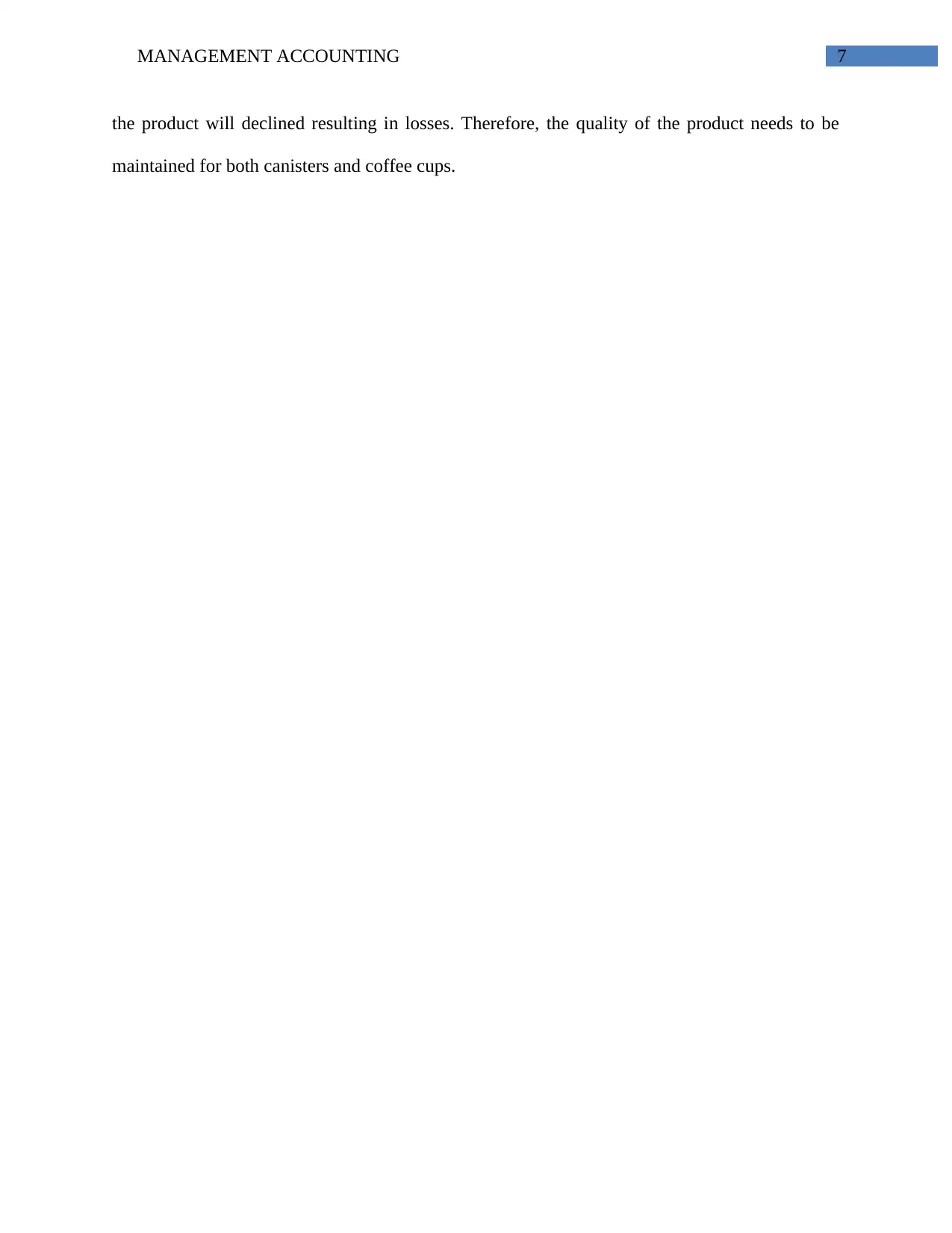
MANAGEMENT ACCOUNTING 7
the product will declined resulting in losses. Therefore, the quality of the product needs to be
maintained for both canisters and coffee cups.
the product will declined resulting in losses. Therefore, the quality of the product needs to be
maintained for both canisters and coffee cups.
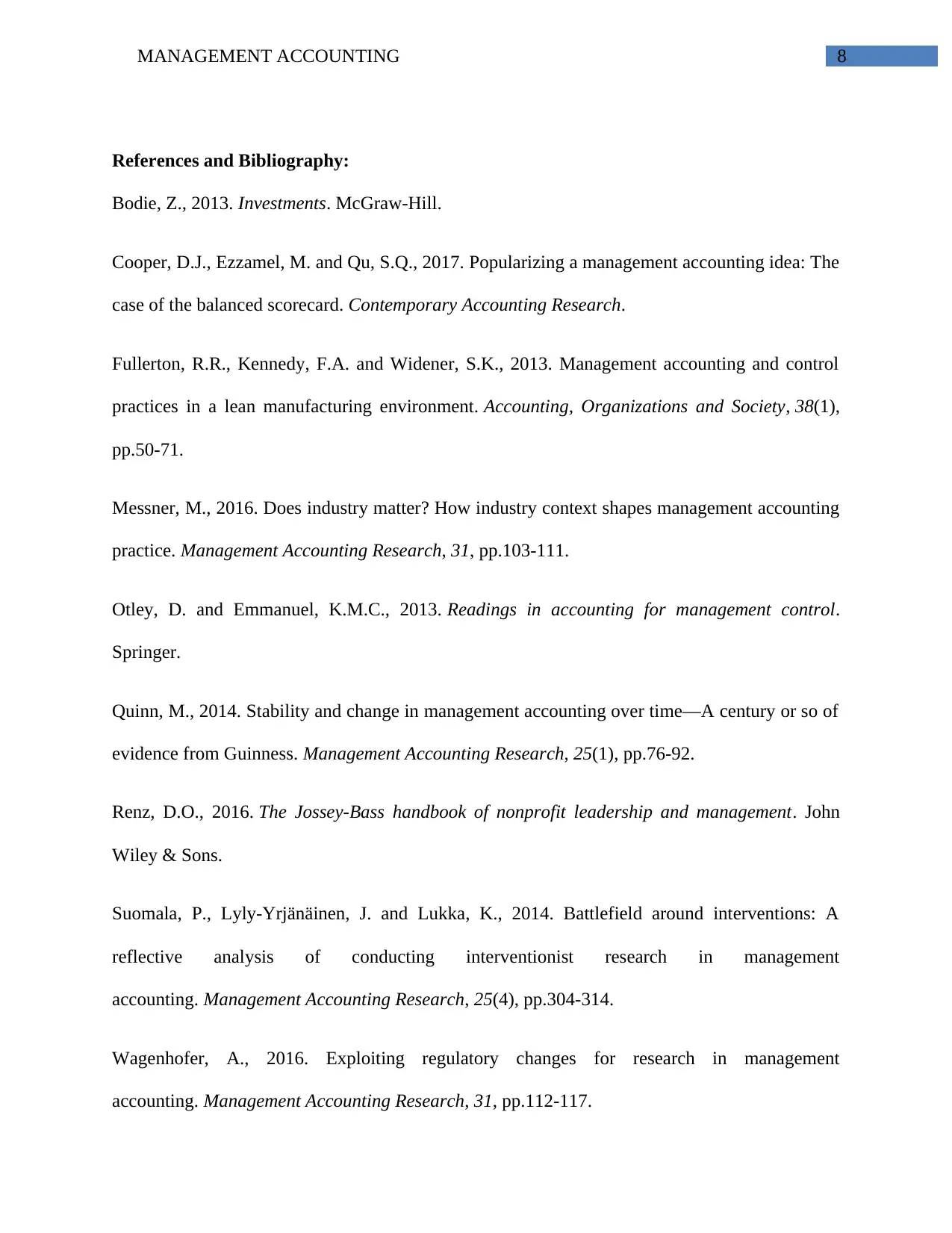
MANAGEMENT ACCOUNTING 8
References and Bibliography:
Bodie, Z., 2013. Investments. McGraw-Hill.
Cooper, D.J., Ezzamel, M. and Qu, S.Q., 2017. Popularizing a management accounting idea: The
case of the balanced scorecard. Contemporary Accounting Research.
Fullerton, R.R., Kennedy, F.A. and Widener, S.K., 2013. Management accounting and control
practices in a lean manufacturing environment. Accounting, Organizations and Society, 38(1),
pp.50-71.
Messner, M., 2016. Does industry matter? How industry context shapes management accounting
practice. Management Accounting Research, 31, pp.103-111.
Otley, D. and Emmanuel, K.M.C., 2013. Readings in accounting for management control.
Springer.
Quinn, M., 2014. Stability and change in management accounting over time—A century or so of
evidence from Guinness. Management Accounting Research, 25(1), pp.76-92.
Renz, D.O., 2016. The Jossey-Bass handbook of nonprofit leadership and management. John
Wiley & Sons.
Suomala, P., Lyly-Yrjänäinen, J. and Lukka, K., 2014. Battlefield around interventions: A
reflective analysis of conducting interventionist research in management
accounting. Management Accounting Research, 25(4), pp.304-314.
Wagenhofer, A., 2016. Exploiting regulatory changes for research in management
accounting. Management Accounting Research, 31, pp.112-117.
References and Bibliography:
Bodie, Z., 2013. Investments. McGraw-Hill.
Cooper, D.J., Ezzamel, M. and Qu, S.Q., 2017. Popularizing a management accounting idea: The
case of the balanced scorecard. Contemporary Accounting Research.
Fullerton, R.R., Kennedy, F.A. and Widener, S.K., 2013. Management accounting and control
practices in a lean manufacturing environment. Accounting, Organizations and Society, 38(1),
pp.50-71.
Messner, M., 2016. Does industry matter? How industry context shapes management accounting
practice. Management Accounting Research, 31, pp.103-111.
Otley, D. and Emmanuel, K.M.C., 2013. Readings in accounting for management control.
Springer.
Quinn, M., 2014. Stability and change in management accounting over time—A century or so of
evidence from Guinness. Management Accounting Research, 25(1), pp.76-92.
Renz, D.O., 2016. The Jossey-Bass handbook of nonprofit leadership and management. John
Wiley & Sons.
Suomala, P., Lyly-Yrjänäinen, J. and Lukka, K., 2014. Battlefield around interventions: A
reflective analysis of conducting interventionist research in management
accounting. Management Accounting Research, 25(4), pp.304-314.
Wagenhofer, A., 2016. Exploiting regulatory changes for research in management
accounting. Management Accounting Research, 31, pp.112-117.
⊘ This is a preview!⊘
Do you want full access?
Subscribe today to unlock all pages.

Trusted by 1+ million students worldwide
1 out of 9
Related Documents
Your All-in-One AI-Powered Toolkit for Academic Success.
+13062052269
info@desklib.com
Available 24*7 on WhatsApp / Email
![[object Object]](/_next/static/media/star-bottom.7253800d.svg)
Unlock your academic potential
Copyright © 2020–2025 A2Z Services. All Rights Reserved. Developed and managed by ZUCOL.





